This activity educates students about the Water Cycle, the constant circulation of water around Earth. The Joint Polar Satellite System (JPSS), a collaborative effort between NOAA and NASA, monitors the movement of water throughout Earth’s surface, oceans, and atmosphere in order to forecast local and regional weather. The data from these measurements provide the nation with accurate weather forecasts, hurricane warnings, and much more! Provided at the end of the lesson is a game to help students understand the never-ending process of Earth’s Water Cycle.
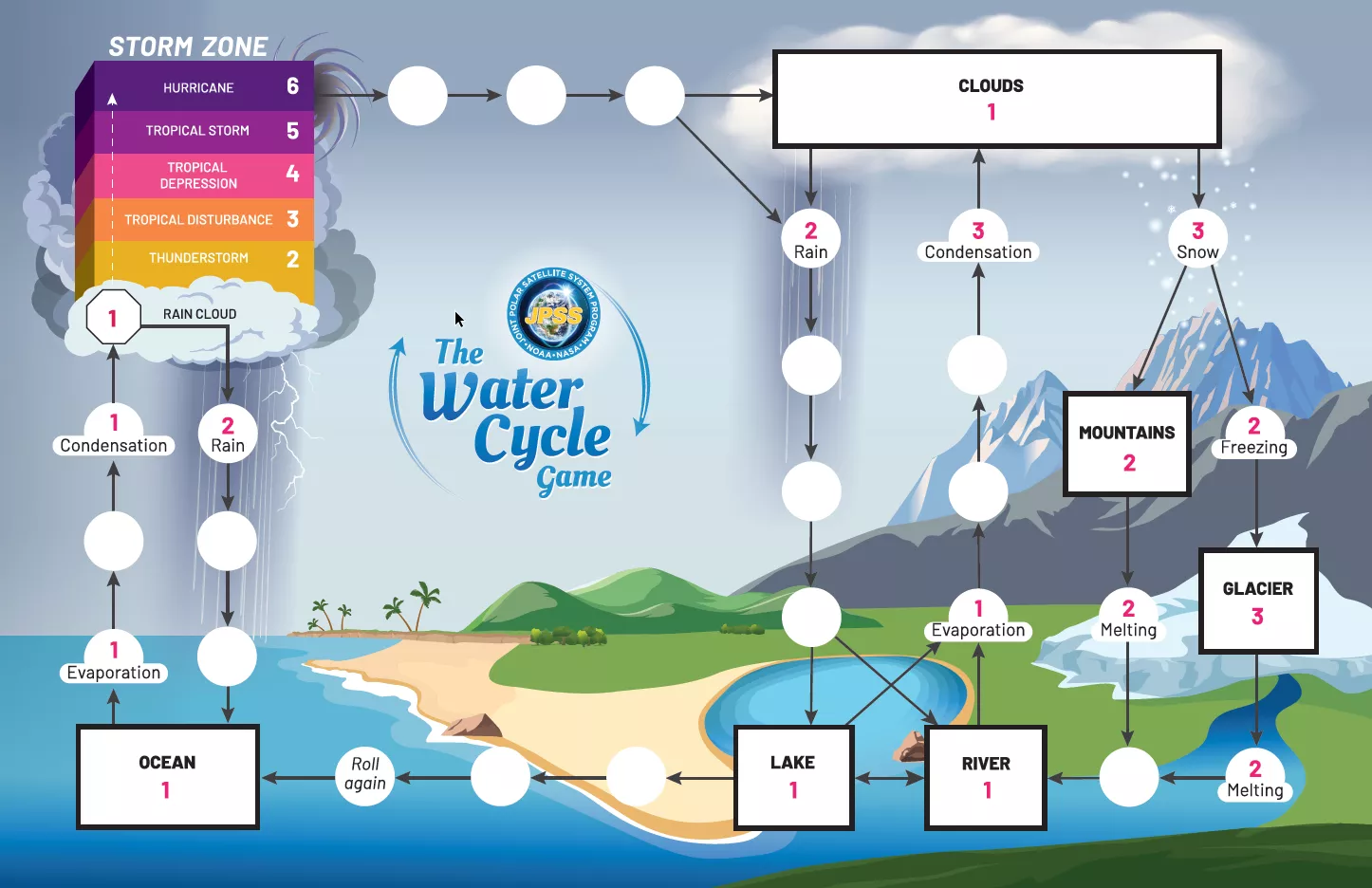
Learning Objectives
Next Generation Science Standards (Grades K–4)
| Performance Expectation | Disciplinary Core Ideas | Description |
|---|---|---|
| K-ESS2-1 Earth’s Systems |
ESS2.D: Weather and Climate | Weather is the combination of sunlight, wind, snow or rain, and temperature in a particular region at a particular time. People measure these conditions to describe and record the weather and to notice patterns over time. |
| 2-PS1-1 Matter and Its Interactions |
PS1.A: Structure and Properties of Matter | Different kinds of matter exist and many of them can be either solid or liquid, depending on temperature. Matter can be described and classified by its observable properties. |
| 2-ESS2-3 Earth’s Systems |
ESS2.C: The Roles of Water in Earth’s Surface Processes | Water is found in the ocean, rivers, lakes, and ponds. Water exists as solid ice and in liquid form. |
| 2-PS1-4 Matter and Its Interactions |
PS1.B: Chemical Reactions | Heating or cooling a substance may cause changes that can be observed. Sometimes these changes are reversible, and sometimes they are not. |
Vocabulary
| Water Cycle: | The natural process through which water moves around Earth’s surface, oceans, and atmosphere. |
| Water Vapor: | Water in gas form. |
| States of Water: | Solid, liquid and gas. |
| Phase Change: | When water changes from one state to another. |
| Melting: | Water changing from solid to liquid. |
| Freezing: | Water changing from liquid to solid. |
| Evaporation: | Water changing from liquid to vapor, rising from the surface to the atmosphere. |
| Condensation: | Water changing from vapor to liquid. The process forming clouds. |
| Precipitation: | Water falling to Earth’s surface as rain, snow, hail, etc. |
| Weather Forecast: | A prediction of future weather. |
| Polar Orbit: | An orbit in which a satellite circles Earth by passing above the North and South Poles. |
What on Earth is the water cycle?
Earth is called the “Blue Planet” due to abundant water on its surface. In fact, water covers most of Earth’s surface.
All life on Earth depends on water. Plants and animals absorb and drink water. We also use water to cook, clean, grow food, travel, and for much more. Water even makes up most of our body weight.
Water is constantly moving around Earth’s surface, oceans and atmosphere. Scientists call this global process the water cycle.
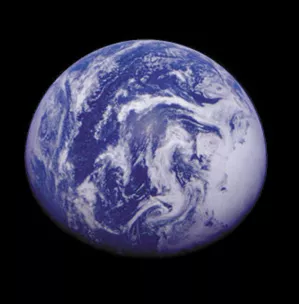
The Galileo spacecraft took this image of Earth in 1990. The Pacific Ocean covers virtually all of the visible disk of Earth in the picture.
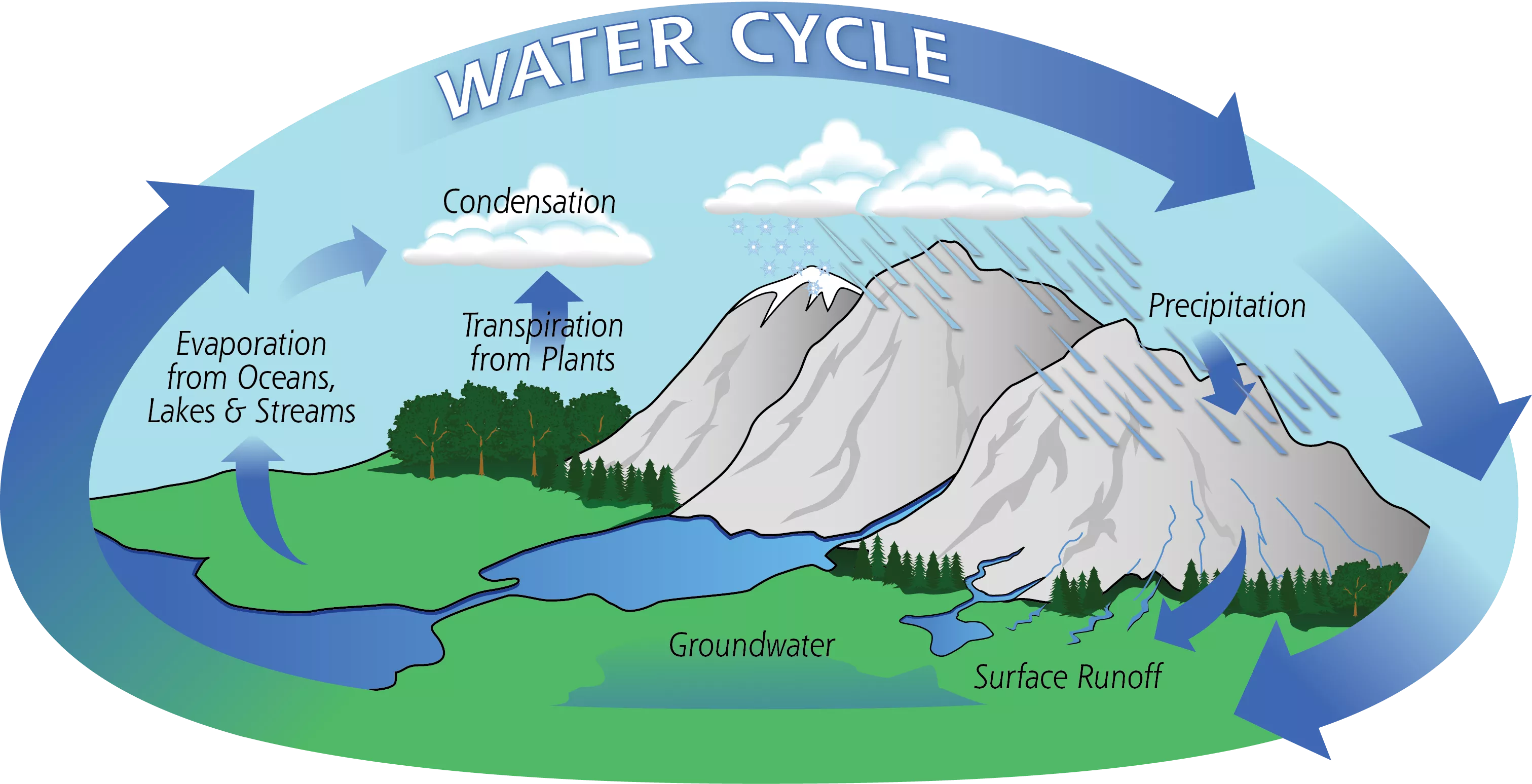
The above image shows the Earth’s water cycle. The water cycle is the movement of water around Earth’s surface, oceans, and atmosphere. The water cycle has been going on for billions of years! JPSS monitors all the water vapor in the atmosphere and where it is moving.
Solid, liquid, and gas - The three states of water
As water moves around the Earth, it can change into a solid (ice), liquid (rain) and gas (vapor). Scientists call solid, liquid, and gas the three states of water.
Solid ice is found in ice sheets, glaciers, and snow in the mountains or at the North and South Poles.
Liquid water is found in the oceans, rivers, lakes,streams and even underground.
Water vapor (or water in the gas state) is found in the clouds.
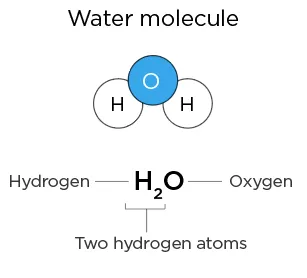
H2O is the chemical formula for water. A water molecule is made from two hydrogen atoms (H2) and one oxygen atom (O).
How does water change into a solid, liquid or gas?
When the temperature of water changes, so does its state. Scientists call a change from one state to another a phase change.
- Melting occurs when solid ice or snow warms up and changes to liquid.
- Freezing occurs when liquid water gets cold and changes to solid ice.
- Evaporation occurs when liquid water warms up and changes to gas (or water vapor). When evaporation occurs, water vapor rises into the atmosphere.
- Condensation occurs when gas (or water vapor) cools down and changes to liquid. Condensation is the process forming clouds or water droplets on the outside of a window or glass of water.
The states and phase changes helping water move through Earth’s surface, oceans and atmosphere make up the water cycle. Without the water cycle, water would stay in one place.
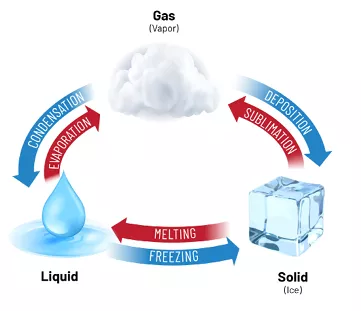
The three states of water are solid (ice), liquid (rain), and gas (vapor). Melting, freezing, evaporation and condensation are four of the six phase changes of water.
The water cycle and weather
The water cycle helps plants grow, provides all life on Earth with fresh drinking water, and even influences the daily weather and climate.
Common weather factors such as heat, moisture, sunshine, wind, clouds, rain and snow are all influenced by how much water is in the atmosphere.
If there is little water in the atmosphere, the will be no clouds, rain, or snow.
The water cycle is also responsible for severe weather events such as droughts, blizzards, and hurricanes.
The weather affects our everyday lives and scientists want to find severe weather events before they occur. By using satellites to watch the water cycle from space, scientists can forecast weather.
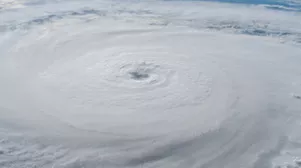
Hurricane Lane, with its well-defined eye, was pictured as a category 5 storm southwest of the Hawaiian Islands as the International Space Station orbited above. Hurricanes form over warm ocean water in Earth’s tropical regions. A category 5 is the most severe hurricane.
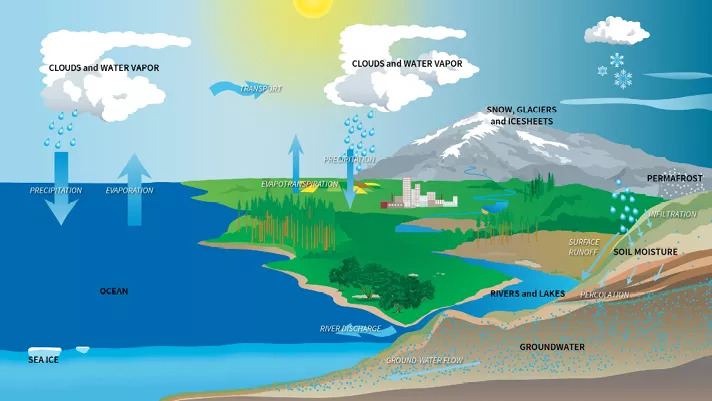
This image shows the many different paths of Earth’s water cycle. For example, the Sun heats up liquid water in the ocean, causing it to evaporate from Earth’s surface, and rise into the atmosphere as water vapor. As the water vapor cools, it condenses into liquid water droplets to form clouds, and falls again to the surface as precipitation. Precipitation is the scientific term for rain, snow, or hail.
The Joint Polar Satellite System
The movement of water in the atmosphere can change the weather in a matter of minutes or hours. Scientists want to know what the weather will be hours and even days in advance, so it doesn’t catch anyone by surprise.
In order to predict the weather, scientists use Earth observing satellites like the Joint Polar Satellite System (JPSS) to constantly monitor water as it changes states and moves throughout Earth’s surface, oceans, and atmosphere.
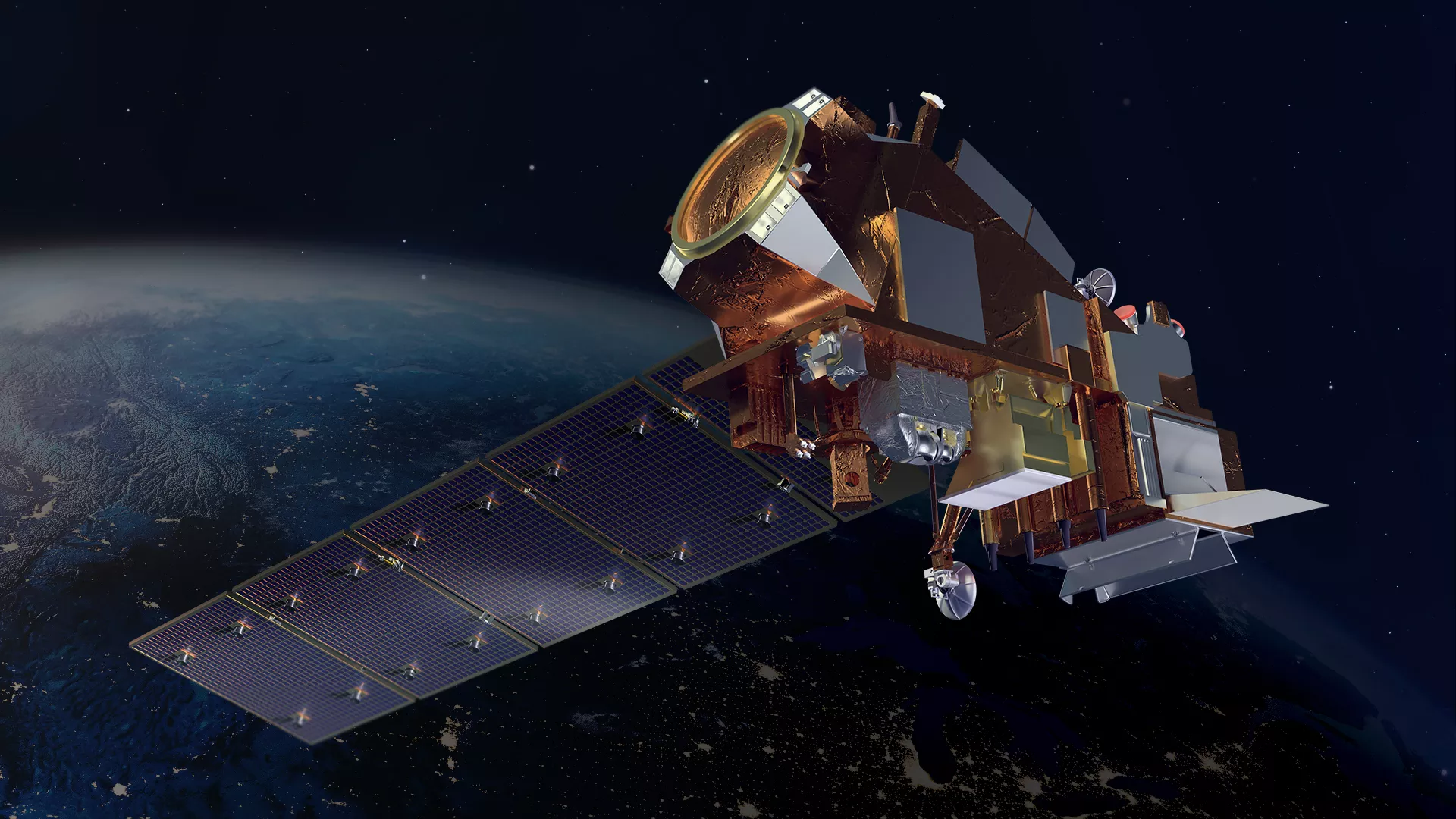
Suomi-NPP, NOAA-20, and NOAA-21 are the 3 satellites in the Joint Polar Satellite System. NOAA-21, shown above, was launched from California’s Vandenberg Air Force Base in 2022.
How does JPSS monitor earth's water?
JPSS uses a polar orbit. In a polar orbit, a satellite circles the Earth by passing above the North and South Poles. While orbiting the poles, Earth spins underneath, allowing JPSS to observe the entire Earth and its water twice in one day.
JPSS uses scientific instruments to observe Earth’s water. These instruments measure the amount of liquid water or water vapor in the oceans and atmosphere. JPSS can also measure the temperature of water anywhere on Earth. This helps scientists identify where a lot of water is and if it is a solid, liquid, or gas.
The water cycle has no beginning or end, but JPSS continues to monitor water across the entire Earth. This includes water in the oceans, rivers, lakes, glaciers, mountains, clouds, thunderstorms, blizzards, and even hurricanes!
Try playing the JPSS Water Cycle Game to learn how water moves around Earth!
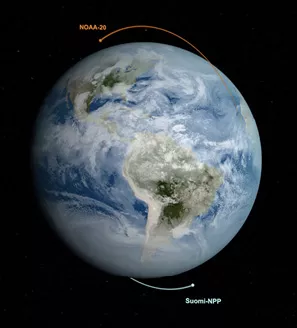
This image shows Suomi NPP and NOAA-20 in their polar orbits. Each satellite completes 14 polar orbits in one day. This allows JPSS to monitor the entire Earth twice a day.
Game Rules
Use your knowledge of Earth’s water cycle to follow the many different paths a drop of water can take around Earth.
Downloads
Below you'll find all the materials needed to play the JPSS Water Cycle game. If you're interested in downloading all the parts, please download the Full Activity Package!
Digital Game Board
PowerPoint and Excel files can also be opened in Google Slides. Game host can share your screen and move players’ game pieces. You can even use an online random die roll like this one: https://www.piliapp.com/random/dice/
